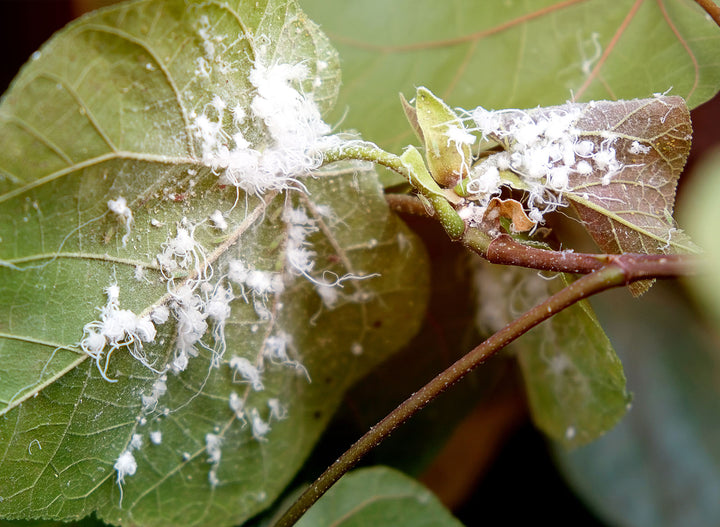The bat faced cuphea (Cuphea llavea) is prized for its unique purple and red bat-shaped flowers that attract pollinators. However, mealybugs can infest and damage these ornamental plants Mealybugs are small, soft-bodied insects that appear as white cottony masses on stems and leaves. They extract sap, causing yellowing, wilting, stunted growth, and sticky honeydew secretions that promote sooty mold fungi If you find mealybugs attacking your bat faced cupheas, take action right away. This guide covers effective methods to eliminate mealybugs and protect your plants.
Identifying Mealybugs on Bat Faced Cuphea
Check your bat faced cuphea frequently for early signs of mealybug infestation:
- White cottony clusters on stems, leaves, and flower buds
- Honeydew droplets on foliage
- Sooty black mold on leaves
- Stunted or yellowing plants
- Ants gathering on plants
Magnify any fuzzy white spots to examine if mealybugs are present They cause gradual damage over time so detecting them early is key
Non-Chemical Mealybug Treatments
Start with gentle, eco-friendly techniques to get rid of mealybugs on bat faced cuphea:
-
Wash off – Use a strong stream of water to dislodge mealybugs from foliage,
-
Rub off – Gently rub them off using a cotton swab dipped in alcohol.
-
Prune infestations – Remove heavily infected parts to prevent spread.
-
Apply neem oil – Neem oil smothers and kills mealybugs safely. Spray every 7-10 days.
-
Release ladybugs – Natural predators that eat mealybugs.
-
Use sticky traps – Traps intercept adult mealybugs and reveal infestations.
-
Improve airflow – Space plants properly to allow airflow and reduce humidity.
Chemical Treatments for Mealybugs
If non-chemical methods are ineffective, use pesticides as a last resort:
-
Insecticidal soaps – Potent yet safe for plants and humans. Spray mealybugs directly.
-
Horticultural oils – Smother mealybugs on contact while safe for most plants.
-
Systemic insecticides – Absorbed by plants and kill insects feeding on it. Use with caution.
Carefully follow all label directions when using chemical pesticides. Repeat applications are likely needed.
Preventing Mealybugs on Bat Faced Cuphea
Prevention is crucial since mealybugs are difficult to eradicate. Here are some tips:
-
Inspect plants routinely, including under leaves for early detection
-
Remove weeds, dead leaves, and debris that harbor mealybugs
-
Disinfect tools and gloves after handling infected plants
-
Quarantine and treat new plants before introducing to your garden
-
Apply neem oil or insecticidal soap proactively
-
Ensure proper air circulation and avoid overcrowding plants
-
Water at soil level and avoid wetting foliage
What to Do If Your Plant Has Mealybugs
If you spot mealybugs on your bat faced cuphea:
-
Isolate infected plants immediately to prevent spread.
-
Remove heavily infested parts and dispose properly.
-
Wash plants with a strong stream of water.
-
Apply insecticidal soap or neem oil according to label.
-
Continue monitoring and repeat applications to kill juvenile mealybugs.
-
Maintain vigilant prevention measures moving forward.
Catching infestations early allows for more effective management. With prompt treatment and proper care, your bat faced cuphea will thrive mealybug-free.

Evicting Pests and Curing Diseases
Once youve spotted these pests, its eviction time. A strong blast of water can dislodge many of them, but for stubborn squatters, insecticidal soap or neem oil can be your go-to. If youre dealing with a full-blown infestation, you might need to bring out the big guns: miticides or systemic insecticides. Remember, the best offense is a good defense—keep your plant clean and your eyes peeled.
Battling Environmental Stress: Light and Temperature
Recognizing the signs of poor lighting and temperature conditions is crucial for your Bat-faced Cupheas health. If the leaves are fading or have brown edges, it might be a cry for help due to excessive light. Conversely, leggy stems and sparse flowering suggest a light deficit. Temperature-wise, watch for slowed growth or wilting, which can signal that your plant is too hot or too cold.
Taking Care of a BAD Mealybug Infestation! ♀️ // Garden Answer
FAQ
How do I get rid of mealybugs permanently?
Will my plant recover from mealybugs?
Does vinegar get rid of mealy bugs?
How to care for bat face Cuphea?
What is a bat face Cuphea plant?
Native to Central America and Mexico, bat face cuphea plant (Cuphea llavea) is named for its interesting little bat-faced blooms of deep purple and bright red. Read this article for helpful informatio
How do you grow a bat-faced Cuphea?
Grow bat-faced cuphea in full sun in the ground or in containers. Provide regular moisture, although plants will tolerate dry conditions occasionally. Fertilize plants in containers several times during the summer months. Pinch back or shear if plants become too leggy later in the growing season.
Why is it called a bat faced Cuphea?
It gets its common name of bat faced cuphea from the striking resemblance of its blooms to the face of a bat. Other common names include bunny ears, cuphea, red cuphea, St. Peter’s plant, and tiny mice. This broadleaf evergreen sub-shrub is native to Mexico and other parts of Central America.
What is a bat-faced Cuphea?
The common name bat-faced cuphea comes from the resemblance of the ends of the flower to a tiny bat face but it may also be called red cuphea or just cuphea (along with several other species; orange bat-faced cuphea is a different species, C. oreophila.) Bat-faced cuphea produces many stems (L) with pointed, hairy ovate leaves (R).
